|
. . . . AND THOSE AROUND TRING
CHAPTER XV.
WINDMILLS
IN LITERATURE
IN PROSE
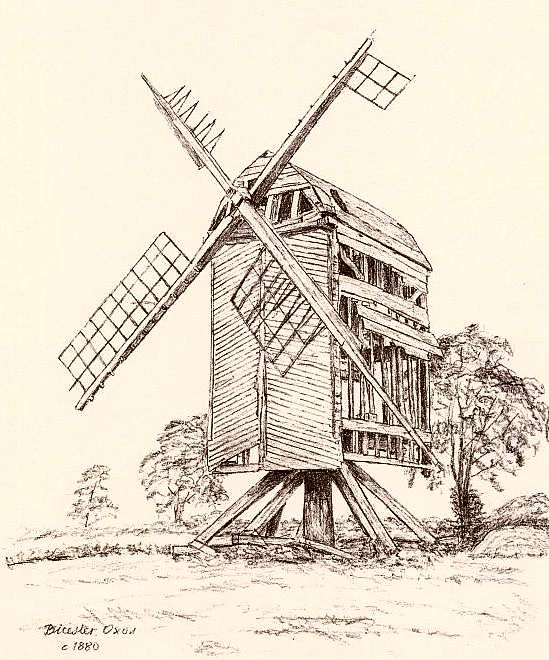
Fig. 15.1: Middleton Road post
mill, Bicester c.1880.
Built c.1675, blown down in 1881.
Could there be a more picturesque reminder of old English life, or
any feature in more perfect harmony with its rural surroundings,
than a venerable old wooden windmill? Whether standing on a far
hilltop or on a gentle rise in the valley, its place in the picture
was always pleasing, often its centre of attraction. In the opinion
of Robert Louis Stevenson (The Foreigner at Home) . . . .
“There are, indeed, few merrier spectacles than that of many
windmills bickering together in a fresh breeze over a woody country;
their halting alacrity of movement, their pleasant business, making
bread all day with uncouth gesticulations, their air, gigantically
human, as of a creature half alive, put a spirit of romance into the
tamest landscape.”
Such romantic scenes live now only in pictures. Here, Walter Rose
(The Village Carpenter) describes the exhilaration he experienced as
a child, standing before those selfsame uncouth, gesticulating sails
. . . .
“The sails always reached to about two feet from the ground, and it
was an enthralling experience to stand before them, as I often did,
when a stiff wind was blowing, and watch them go roaring by: to note
the ‘swoop,’ ‘swoop’ of each sail as it passed and to follow the
orbit of one as it rose to almost sixty feet in the air, immediately
to descend and swiftly pass again.”
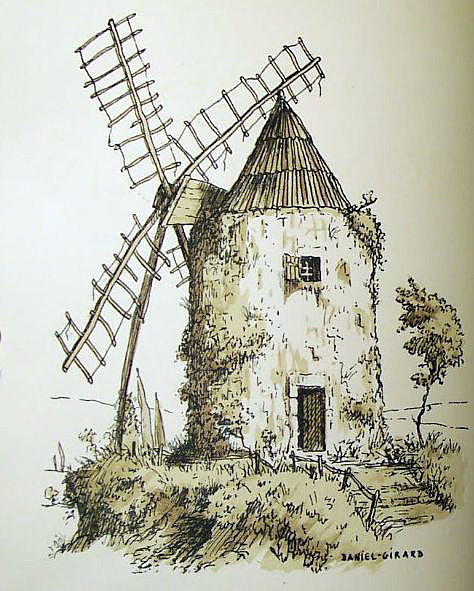
Fig. 15.2: frontispiece,
Lettres de mon Moulin
In Lettres de mon Moulin, Alphonse Daudet reflects upon the
disappearing windmill and the way of life that once centred upon it
. . . .
“At one time there was a great milling trade, and from thirty miles
around the people of the mas brought us their wheat to grind. . . .
All about the village the hills were covered with windmills. Right
and left your eye fell upon arms revolving in the mistral above the
tops of the pine-trees, upon endless numbers of little donkeys laden
with sacks, trotting up hill and down dale along the roads; and the
whole week through it was a pleasure to hear on our hill-top the
cracking of whips, the flapping of the arm-sails, and the ‘gee-up’
of the millers’ boys. . . . On Sundays whole parties of us used to
go up to the mills, where the millers treated us to Muscat wine. Their wives were like queens, decked out in all the bravery of their
lace scarves and gold crosses. I used to bring my fife, and until
black night there was dancing and farandoles. These mills, you see,
were the joy and the wealth of our countryside.
Unfortunately, some Frenchmen from Paris conceived the idea of
establishing a big steam-driven mill on the Tarascon road. There’s
always a craze for anything new! People got into the habit of
sending their corn to the steam mills, and the poor windmills were
left without any work to do. For some time they tried to struggle
on, but steam proved the stronger, and one after another, alas! they
had to close down . . . . No more little donkeys. . . . The handsome
millers’ wives sold their gold crosses . . . . No more Muscat wine!
No more farandole! . . .”
Apart from Muscat and farandoles, a miller’s life could be hard, as
is portrayed by Julia Ewing in Jan of the Windmill . . . .
“In a coat and hat of painted canvas, he had been in and out ever
since the storm began; now directing the two men who were working
within, now struggling along the stage that ran outside the
windmill, at no small risk of being fairly blown away.
He had reefed the sails twice already in the teeth of the blinding
rain. But he did well to be careful. For it was in such a storm as
this, five years ago ‘come Michaelmas’, that the worst of windmill
calamities had befallen him, — the sails had been torn off his mill
and dashed into a hundred fragments upon the ground. And such a
mishap to a seventy feet tower mill means — as windmillers well know
— not only a stoppage of trade, but an expense of two hundred pounds
for the new sails . . . . That catastrophe had kept the windmiller a
poor man for five years, and it gave him a nervous dread of storms.”
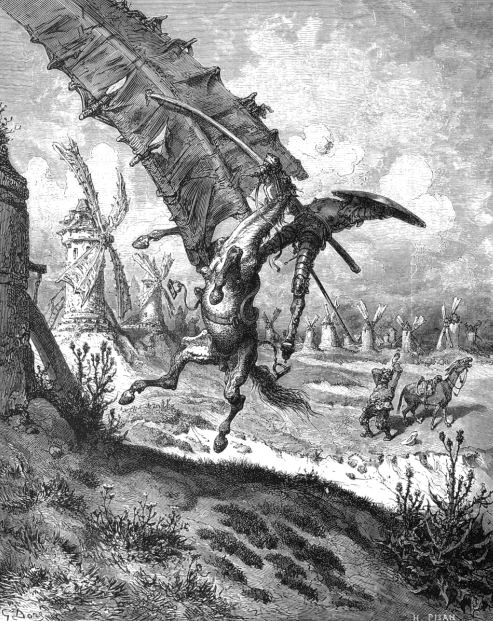
Fig. 15.3: Don Quixote tilting at a windmill, by Gustave Doré
The most famous episode in all of literature to feature windmills
must surely be that which appears in Cervantes’ novel Don Quixote. In one of his adventures, the Don imagines the sails of a group of
windmills to be the waving arms of giants. This famous scene gives
rise to the idiom “tilting at windmills”, meaning to attack
imaginary enemies or to fight futile battles. The word ‘tilt’, in
this context, comes from jousting, which is precisely what the Don’s
fevered imagination leads to . . . .
“Just then they came in sight of thirty or forty windmills that rise
from that plain. And no sooner did Don Quixote see them that he said
to his squire, ‘Fortune is guiding our affairs better than we
ourselves could have wished. Do you see over yonder, friend Sancho,
thirty or forty hulking giants? I intend to do battle with them and
slay them. With their spoils we shall begin to be rich for this is a
righteous war and the removal of so foul a brood from off the face
of the earth is a service God will bless.’
‘What giants?’ asked Sancho Panza.
‘Those you see over there,’ replied his master, ‘with their long
arms. Some of them have arms well nigh two leagues in length.’
‘Take care, sir,’ cried Sancho. ‘Those over there are not giants but
windmills. Those things that seem to be their arms are sails which,
when they are whirled around by the wind, turn the millstone.’”
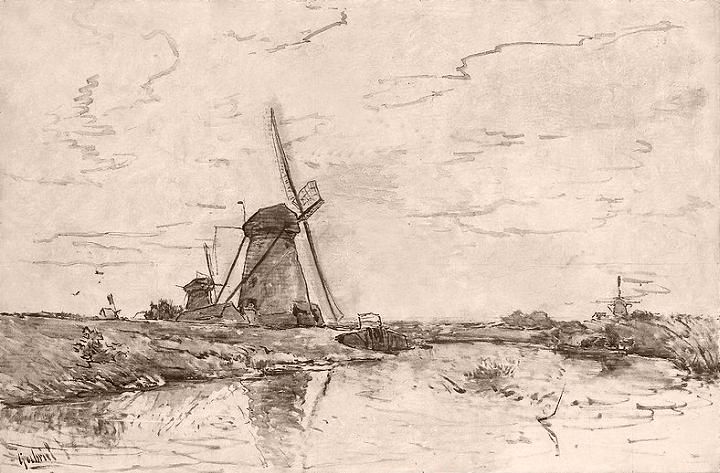
Fig. 15.4: Paul Joseph
Constantin Gabriël, English Landscape with Mills
――――♦――――
IN VERSE
More classical allusions to windmills appear in Shakespeare. In
Henry IV Part I, Act 3, Harry Hotspur says to Mortimer, Earl of
March . . . .
|
“. . . . . O! he’s as tedious
As a tired horse, a railing wife;
Worse than a smoky house. I had rather live
With cheese and garlic in a windmill, far,
Than feed on cates and have him talk to me,
In any summer-house in Christendom.” |
But a cheese and garlic sandwich might go down remarkably well in a
windmill, particularly if during the repast one can gaze down on
acre upon acre of wheat, barley, oats or whatever, with a flock or
herd grazing here or there and the odd farmhouse dotted about the
patchwork sea of colour. Falstaff and his companions would surely
have revelled to their heart’s content in cheese and garlic perched
in such a position, for in the second part of Henry IV Act 3,
Justice Shallow remarks to this bulky man, who had “a kind of
alacrity in sinking” . . . .
"O, Sir John, do you remember since we all lay at night in the
windmill in Saint George’s Fields? . . . . Ha, it was a merry
night!"
The Anglo-French writer Hilaire Belloc actually owned a working
smock mill; Shipley Mill in Sussex formed part of an estate that he
bought in 1905. Belloc employed a miller, and windmilling continued
there until 1926. Thereafter he maintained the fabric but, following
his death in 1953, the mill was found to be in a sad state of
repair. It was then that friends raised money to restore it as a
tribute to the writer.
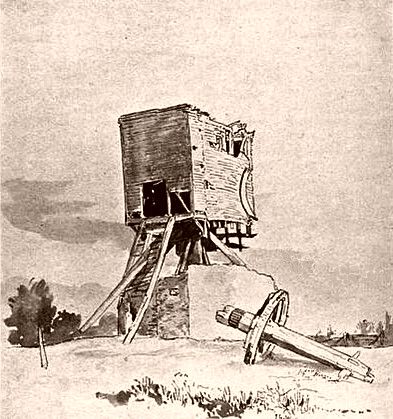
Fig. 15.5: ruined post mill at
Stratford, 1901
Halnaker (pronounced Ha’nacker) Mill, the subject of this melancholy
poem from 1912, stands on Halnaker Hill north-east of Chichester. In
the poem, Belloc reflects on the collapse of the mill (struck by
lightning), which he uses as a metaphor for the decay of the
prevailing moral and social system.
|
HA’NACKER MILL
Sally is gone that was so kindly,
Sally is gone from Ha’nacker Hill
And the Briar grows ever since then so blindly;
And ever since then the clapper is still . . .
And the sweeps have fallen from Ha’nacker Mill.
Ha’nacker Hill is in Desolation:
Ruin a-top and a field unploughed.
And Spirits that call on a fallen nation,
Spirits that loved her calling aloud,
Spirits abroad in a windy cloud.
Spirits that call and no one answers —
Ha’nacker’s down and England’s done.
Wind and Thistle for pipe and dancers,
And never a ploughman under the Sun:
Never a ploughman. Never a one. |
In The Windmill, Robert Bridges describes the miller in situ,
account book in hand, thus laying emphasis on the commercial
realities of a miller’s life. His descriptive details with “creaking
sails” and “shuddering timbers” conjure up a vision that anyone who
has visited a working windmill will recognize.
|
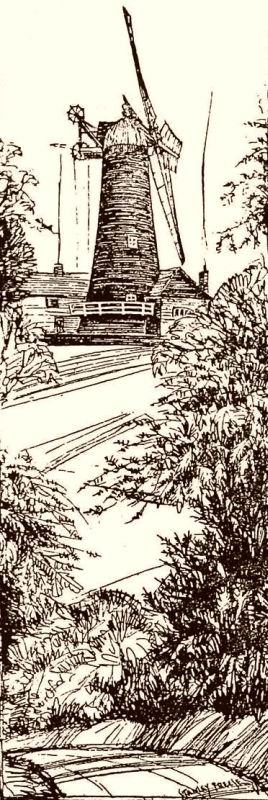 |
THE WINDMILL
The green corn waving in the dale,
The ripe grass waving on the hill:
I lean across the paddock pale
And gaze upon the giddy mill.
Its hurtling sails a mighty sweep
Cut thro’ the air: with rushing sound
Each strikes in fury down the steep,
Rattles, and whirls in chase around.
Beside his sacks the miller stands
On high within the open door:
A book and pencil in his hands,
His grist and meal he reckoneth o’er.
His tireless merry slave the wind
Is busy with his work to-day:
From whencesoe’er he comes to grind;
He hath a will and knows the way.
He gives the creaking sails a spin,
The circling millstones faster flee,
The shuddering timbers groan within,
And down the shoots the meal runs free.
The miller giveth him no thanks,
And doth not much his work o’erlook:
He stands beside the sacks, and ranks
The figures in his dusty book. |
|
Fig. 15.6:
Hawridge tower mill,
by Stanley Freece |
|
|
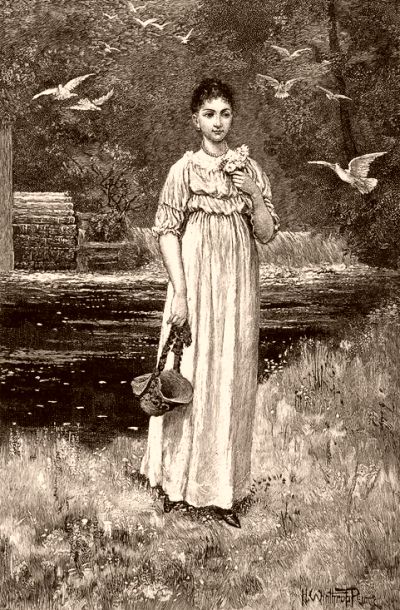 |
|
Fig. 15.7:
the Miller’s
Daughter,
by Herman
Winthrop Peirce (1891) |
Alfred Lord Tennyson follows Bridges’ allusion to the miller’s grip
on the world of business. Here, he describes a prosperous and
contented man, but one “full of dealings with the world”. . . .
|
THE MILLER’S DAUGHTER
I see the wealthy miller yet,
His double chin, his portly size,
And who that knew him could forget
The busy wrinkles round his eyes?
The slow wise smile that, round about
His dusty forehead drily curl’d,
Seem’d half-within and half-without,
And full of dealings with the world? |
As for the miller’s daughter, the Laureate’s feelings, tenderly
expressed, are thus . . . .
|
It is the miller’s daughter,
And she is grown so dear, so dear,
That I would be the jewel
That trembles in her ear:
For hid in ringlets day and night,
I’d touch her neck so warm and white . . .
. . . . And I would be the necklace,
And all day long to fall and rise
With her laughter or her sighs:
And I would lie so light, so light,
I scarce should be unclasp’d at night. |
With so much grain in evidence, the risk of a vermin infested mill
is a real problem. Here, Walter de la Mare pays recognition to the
miller’s countermeasure . . . .
|
FIVE EYES
In Hans’ old mill his three black cats
Watch his bins for the thieving rats.
Whisker and claw, they crouch in the night,
Their five eyes smouldering green and bright:
Squeaks from the flour sacks, squeaks from where
The cold wind stirs on the empty stair,
Squeaking and scampering, everywhere.
Then down they pounce, now in, now out,
At whisking tail, and sniffing snout;
While lean old Hans he snores away
Till peep of light at break of day;
Then up he climbs to his creaking mill,
Out come his cats all grey with meal —
Jekkel, and Jessup, and one-eyed Jill. |
. . . . and not to forget the source of the windmill’s motive power;
this by Christina Rossetti . . . .
|
WHO HAS SEEN THE WIND?
Neither I nor you.
But when the leaves hang trembling,
The wind is passing through.
Who has seen the wind?
Neither you nor I.
But when the trees bow down their heads,
The wind is passing by. |
Reference was made in Chapter IX on Hawridge windmill, to the writer
Gilbert Cannan who rented the mill after its conversion to private
living accommodation. In his study at the very top of the mill, he
wrote copiously, including a book of verse from which this extract
is taken . . . .
|
ADVENTUROUS LOVE AND OTHER
VERSES
I have a room wherein each day I sit
Word-weaving. I have windows south, east, west,
And with the changing sky my eyes are blest
Over this wide Heaven I let my wit
And fancy roam. My thoughts like birds do flit
Against the clouds in happy, happy quest
Of straws and twigs and moss to build their nest.
This is the spring when days with love are lit. |
Amateur poets have also paid tribute to windmills. This anonymous
sonnet pictures a feudal landlord and owner of a windmill — to which
his tenants are obliged to take their grain — reflecting on his idle way
of life, as idle as the slumbering landscape that surrounds
him. He tries to create an impression of industry for the “bustling
world” to see, but guilty conscience or not the landlord collects
his toll, which his miller deducts “in kind”.
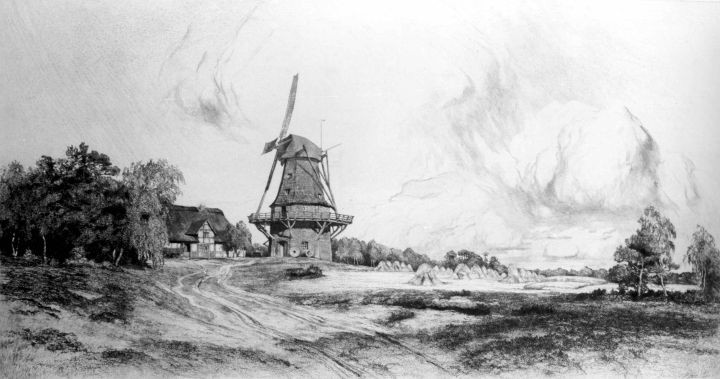
Fig. 15.8: smock mill
|
THE LANDLORD’S TOLL
I pause to gaze across the weald —
There seems to be no life astir
Save a skylark soaring in the air
Caroling o’er a wheat-filled field;
And on this landscape, patch-worked jade,
Stillness lies; no other life is visible
But the slow-winding sails of my old windmill
Play flitting change with sun and shade.
In this place I follow my idle way,
As the bustling world would judge it,
Like a windmill I twirl my arms all day
And try to look committed.
Though I toil not for what we grind
The miller mulcts my toll in kind! |
James Edwin Saunders was a miller from Slough. He died in 1935, aged
91, after a lifetime spent in windmilling that brought him immense
satisfaction in spite of once being on the brink of bankruptcy.
James kept a diary in which his conflicts and consolations are
recorded, mostly in rhyme; one of his long poems, which sums up his
feelings for his craft, begins . . . .
|
MUSIC OF THE MILL
There is poetry in Milling, when one’s heart is free
From the care that blinds one’s vision — oft ‘twas so with me
To a large extent, though even in those anxious days
There were times when I had glimpses of its transient rays.
How I like to see good running and due pleasure found
In the Mill’s efficient working, as I walked around.
When I went to bed I saw it still before my eye,
Still I heard the music stealing like a lullaby,
Soothing me to sleep and dreamland like an evening psalm,
After days of busy effort, like a restful balm. |
Another amateur poet, H. E. Howard, from Chesham, wrote 50 Poems of
Buckinghamshire. A few lines from the beginning of one of these
poems, written in 1935 . . . .
|
HAWRIDGE COMMON
At noon among the rolling hills I strayed
And watched the bearded ploughman. In the
vale
The February sun sang out and strayed
Up o’er the bramble slope until the sail
Of that old windmill tried to live again.
The wind tip-toed on every blade of grass;
And shimmering ponds as smooth
as smoothest glass. |
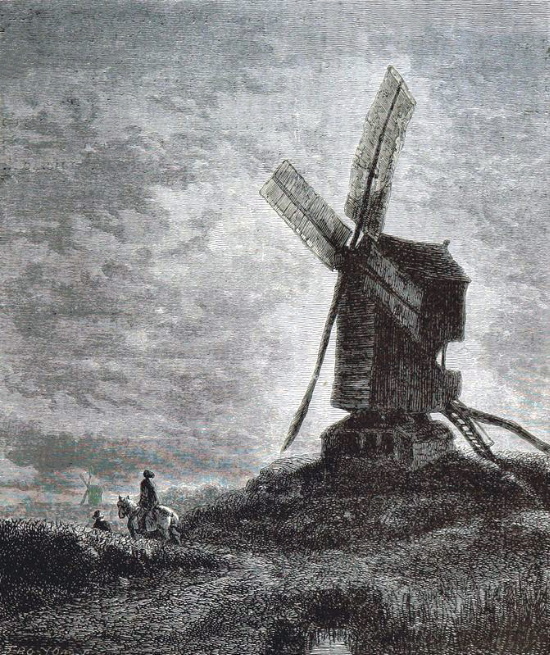
Fig. 15.9:
Le Monde vu par les artistes (p.11), René
Joseph Ménard (1881)
The last poem needs little introduction, for it must be the best
known of what windmill poems there are, and one of Henry Wadsworth
Longfellow’s most enduring . . . . |